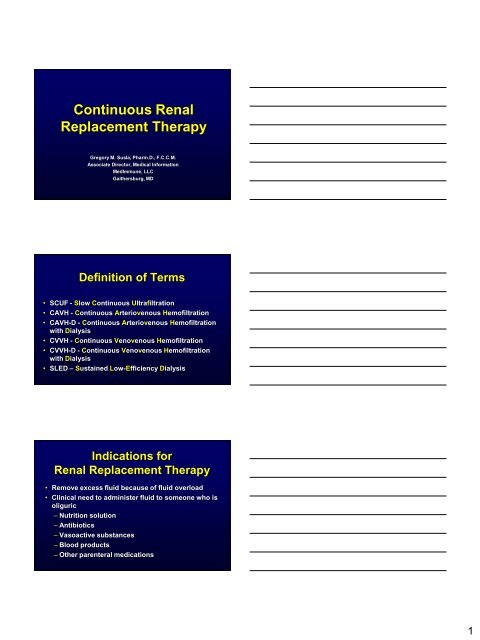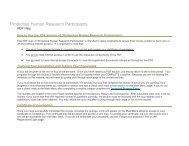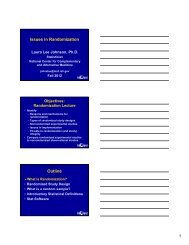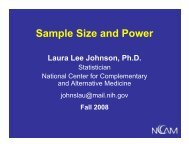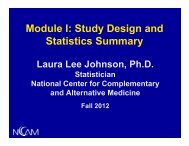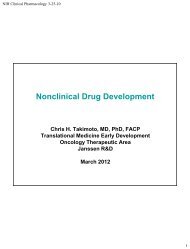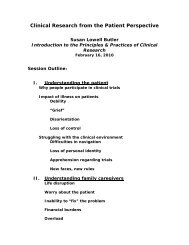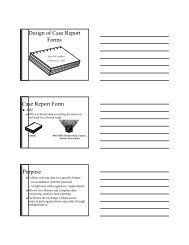Renal replacement therapy_Susla (3)
Renal replacement therapy_Susla (3)
Renal replacement therapy_Susla (3)
Create successful ePaper yourself
Turn your PDF publications into a flip-book with our unique Google optimized e-Paper software.
Continuous <strong>Renal</strong><br />
Replacement Therapy<br />
Gregory M. <strong>Susla</strong>, Pharm.D., F.C.C.M.<br />
Associate Director, Medical Information<br />
MedImmune, LLC<br />
Gaithersburg, MD<br />
Definition of Terms<br />
• SCUF - Slow Continuous Ultrafiltration<br />
• CAVH - Continuous Arteriovenous Hemofiltration<br />
• CAVH-D - Continuous Arteriovenous Hemofiltration<br />
with Dialysis<br />
• CVVH - Continuous Venovenous Hemofiltration<br />
• CVVH-D - Continuous Venovenous Hemofiltration<br />
with Dialysis<br />
• SLED – Sustained Low-Efficiency Dialysis<br />
Indications for<br />
<strong>Renal</strong> Replacement Therapy<br />
• Remove excess fluid because of fluid overload<br />
• Clinical need to administer fluid to someone who is<br />
oliguric<br />
– Nutrition solution<br />
– Antibiotics<br />
– Vasoactive substances<br />
– Blood products<br />
– Other parenteral medications<br />
1
Advantages of Continuous<br />
<strong>Renal</strong> Replacement Therapy<br />
• Hemodynamic stability<br />
– Avoid hypotension complicating hemodialysis<br />
– Avoid swings in intravascular volume<br />
• Easy to regulate fluid volume<br />
– Volume removal is continuous<br />
– Adjust fluid removal rate on an hourly basis<br />
• Customize <strong>replacement</strong> solutions<br />
• Lack of need of specialized support staff<br />
Advantages of SLED<br />
• Hemodynamic stability<br />
– Avoid hypotension complicating hemodialysis<br />
– Avoid swings in intravascular volume<br />
• High solute clearance<br />
• Flexible scheduling<br />
• Lack of need for expensive CRRT machines<br />
• Lack of need for custom <strong>replacement</strong> solutions<br />
• Lack of need of specialized support staff<br />
Disadvantages of Continuous<br />
<strong>Renal</strong> Replacement Therapy<br />
• Lack of rapid fluid and solute removal<br />
– GFR equivalent of 5 - 20 ml/min<br />
– Limited role in overdose setting<br />
• SLED – Developing role<br />
• Filter clotting<br />
– Take down the entire system<br />
2
Basic Principles<br />
• Blood passes down one side of a highly<br />
permeable membrane<br />
• Water and solute pass across the membrane<br />
– Solutes up to 20,000 daltons<br />
• Drugs & electrolytes<br />
• Infuse <strong>replacement</strong> solution with physiologic<br />
concentrations of electrolytes<br />
Anatomy of a Hemofilter<br />
blood in<br />
dialysate<br />
out<br />
Cross Section hollow fiber membrane<br />
dialysate<br />
in<br />
blood out<br />
Outside the Fiber<br />
(effluent)<br />
Inside the Fiber<br />
(blood)<br />
Basic Principles<br />
• Hemofiltration<br />
– Convection based on a pressure gradient<br />
– „Transmembrane pressure gradient‟<br />
• Difference between plasma oncotic pressure and<br />
hydrostatic pressure<br />
• Dialysis<br />
– Diffusion based on a concentration gradient<br />
3
CVVH<br />
Continuous Veno-Venous Hemofiltration<br />
to waste<br />
Blood In<br />
(from patient)<br />
Repl.<br />
Solution<br />
Blood Out<br />
(to patient)<br />
LOW PRESS<br />
HIGH PRESS<br />
(Convection)<br />
CVVH<br />
Continuous VV Hemofiltration<br />
• Primary therapeutic goal:<br />
– Convective solute removal<br />
– Management of intravascular volume<br />
• Blood Flow rate = 10 - 180 ml/min<br />
• UF rate ranges 6 - 50 L/24 h (> 500 ml/h)<br />
• Requires <strong>replacement</strong> solution to drive convection<br />
• No dialysate<br />
CVVH Performance<br />
Continuous venovenous hemofiltration<br />
“In vitro” ultrafiltration with blood (post-dilution)<br />
(values ± 15%) (Bovine blood at 37 C, Hct 32%, Cp 60g/l)<br />
4
CVVHDF<br />
Continuous Veno-Venous Hemodiafiltration<br />
Dialysate<br />
Solution<br />
to waste<br />
Blood In<br />
(from patient)<br />
Repl.<br />
Solution<br />
Blood Out<br />
(to patient)<br />
LOW PRESS<br />
LOW CONC<br />
HIGH PRESS<br />
HIGH CONC<br />
(Convection)<br />
(Diffusion)<br />
CVVHDF<br />
Continuous VV Hemodiafiltration<br />
• Primary therapeutic goal:<br />
– Solute removal by diffusion and convection<br />
– Management of intravascular volume<br />
• Blood Flow rate = 10 - 180ml/min<br />
• Combines CVVH and CVVHD therapies<br />
• UF rate ranges 12 - 24 L/24h (> 500 ml/h)<br />
• Dialysate Flow rate = 15 - 45 ml/min (~1 - 3 L/h)<br />
• Uses both dialysate (1 L/h) and <strong>replacement</strong> fluid<br />
(500 ml/h)<br />
SLED<br />
Sustained Low-Efficiency Dialysis<br />
• Primary therapeutic goal:<br />
– Solute removal by diffusion<br />
– Management of intravascular volume<br />
• Blood Flow rate = 100-300 ml/min<br />
• Dialysate Flow rate = 100-300 ml/min<br />
5
Pharmacokinetics<br />
of<br />
Continuous<br />
<strong>Renal</strong> Replacement Therapy<br />
Basic Principles<br />
• Extracorporeal clearance (Cl EC ) is usually considered<br />
clinically significant only if its contribution to total<br />
body clearance exceeds 25 - 30%<br />
Fr EC = Cl EC / Cl EC + Cl R + Cl NR<br />
• Not relevant for drugs with high non-renal clearance<br />
• Only drug not bound to plasma proteins can be<br />
removed by extracorporeal procedures<br />
Determinants of<br />
Drug Removal by CRRT<br />
• Drug<br />
• Membrane<br />
• <strong>Renal</strong> <strong>replacement</strong><br />
technique<br />
Same as hemodialysis<br />
but increased MW range<br />
Permeability, Size<br />
Sieving Coefficient<br />
Convection + diffusion Cl<br />
Flow rates<br />
Duration<br />
Blood, Dialysate, UF<br />
6
Sieving Coefficient (S)<br />
• The capacity of a drug to pass through the hemofilter<br />
membrane<br />
S = C uf / C p<br />
C uf = drug concentration in the ultrafiltrate<br />
C p = drug concentration in the plasma<br />
S = 1 Solute freely passes through the filter<br />
S = 0<br />
Solute does not pass through the filter<br />
CL HF = Q f x S<br />
Determinants of<br />
Sieving Coefficient<br />
• Protein binding<br />
– Only unbound drug passes through the filter<br />
• Protein binding changes in critical illness<br />
• Drug membrane interactions<br />
– Not clinically relevant<br />
• Adsorption of proteins and blood products onto filter<br />
– Related to filter age<br />
– Decreased efficiency of filter<br />
Relationship Between Free Fraction<br />
(fu) and Sieving Coefficient (SC)<br />
SC<br />
7
Dialysate Saturation (S d )<br />
• Countercurrent dialysate flow (10 - 30 ml/min) is<br />
always less than blood flow (100 - 200 ml/min)<br />
• Allows complete equilibrium between blood<br />
serum and dialysate<br />
• Dialysate leaving filter will be 100% saturated<br />
with easily diffusible solutes<br />
• Diffusive clearance will equal dialysate flow<br />
Dialysate Saturation (S d )<br />
S d = C d / C p<br />
C d = drug concentration in the dialysate<br />
C p = drug concentration in the plasma<br />
• Decreasing dialysate saturation<br />
– Increasing molecular weight<br />
• Decreases speed of diffusion<br />
– Increasing dialysate flow rate<br />
• Decreases time available for diffusion<br />
Cl HD = Q d x S d<br />
CVVHDF Clearance<br />
Continuous venovenous hemofiltration - post dilution<br />
QB = 150 ml/min - QD = 2000 ml/h (in vitro saline)<br />
8
Extracorporeal Clearance<br />
• Hemofiltration clearance (Cl HF = Q f x S)<br />
Q f = Ultrafiltration rate<br />
S = Seiving coefficient<br />
• Hemodialysis clearance (Cl HD = Q d x S d )<br />
Q d = Dialysate flow rate<br />
S d = Dialysate saturation<br />
• Hemodialfiltration clearance<br />
Cl HDF = (Q f x S) + (Q d x S d )<br />
Case History<br />
• AP 36yo HM s/p BMT for aplastic anemia<br />
• Admitted to ICU for management of acute renal<br />
failure<br />
• CVVH-D initiated for management of uremia<br />
• ICU course complicated by pulmonary failure failure<br />
requiring mechanical ventilation, liver failure<br />
secondary to GVHD and VOD, and sepsis<br />
Case History<br />
Antibiotic Management on CRRT<br />
• Gentamicin 180 mg IV q24h<br />
• Vancomycin 1 g IV q24h<br />
• Dialysis rate 1000 ml/hour<br />
– 12 hour post gentamicin levels: 3 - 4 mg/L<br />
– 12 hour post vancomycin levels: 20 - 23 mg/L<br />
• Dialysis rate increased to 1200 ml/hour<br />
– 12 hour post gentamicin levels: < 0.4 mg/L<br />
– 12 hour post vancomycin levels: < 4 mg/L<br />
9
Dosage Adjustments in<br />
CRRT/SLED<br />
• Will the drug be removed?<br />
– Pharmacokinetic parameters<br />
• Protein binding < 70 - 80%<br />
– Normal values may not apply to critically ill patients<br />
• Volume of distribution < 1 L/kg<br />
• <strong>Renal</strong> clearance > 35%<br />
• How often do I dose the drug?<br />
– Hemofiltration: „GFR‟ 10 - 20 ml/min<br />
– Hemofiltration with dialysis: „GFR‟ 20 - 50 ml/min<br />
– SLED: „GFR” 10 – 50 ml/min<br />
Dosage Adjustments in<br />
CRRT/SLED<br />
• Loading doses<br />
– Do not need to be adjusted<br />
– Loading dose depends solely on volume of<br />
distribution<br />
• Maintenance doses<br />
– Standard reference tables<br />
– Base on measured loses or blood levels<br />
– Calculate maintenance dose multiplication<br />
factor (MDMF)<br />
Supplemental Dose Based<br />
on Measured Plasma Level<br />
Dose<br />
Suppl<br />
<br />
C<br />
target<br />
Cmeasured<br />
Vd<br />
10
Adjusted Dose Based on<br />
Clearance Estimates<br />
MDMF<br />
<br />
CL<br />
EC<br />
CL<br />
R<br />
CL<br />
CL CL<br />
R<br />
NR<br />
NR<br />
COMPARISON OF DRUG<br />
REMOVAL BY INTERMITTENT<br />
HD AND CRRT<br />
DRUG<br />
CLR + CLNR<br />
(mL/min)<br />
INTERMITTENT<br />
HEMODIALYSIS<br />
MDMF<br />
CONTINUOUS RENAL<br />
REPLACEMENT<br />
CEFTAZIDIME 11.2 1.6 2.2<br />
CEFTRIAZONE 7.0 1.0 3.4<br />
CIPROFLOXACIN 188 1.0 2.4<br />
THEOPHYLLINE 57.4 1.1 1.4<br />
VANCOMYCIN 6 3.9 4.9<br />
COMPARISON OF DRUG<br />
REMOVAL BY SLED AND CRRT<br />
DRUG<br />
CLR + CLNR<br />
(mL/min)<br />
SLED<br />
MDMF<br />
CONTINUOUS RENAL<br />
REPLACEMENT<br />
LINEZOLID 76 1.1 1.4<br />
LEVOFLOXACIN 37 1.4 1.6<br />
MEROPENEM 21 1.6 1.8<br />
VANCOMYCIN 6 2.9 4.8<br />
11


